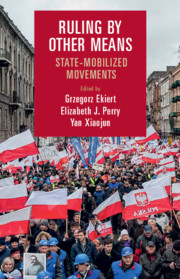Book contents
- Ruling by Other Means
- Cambridge Studies in Contentious Politics
- Ruling by Other Means
- Copyright page
- Contents
- Figures
- Tables
- Contributors
- Acknowledgments
- 1 State-Mobilized Movements: A Research Agenda
- 2 Manufactured Ambiguity
- 3 Suppressing Students in the People’s Republic of China
- 4 State-Mobilized Community Development
- 5 Enforcement Networks and Racial Contention in Civil Rights–Era Mississippi
- 6 Social Sources of Counterrevolution
- 7 Occupy Youth!
- 8 State-Mobilized Movements after Annexation of Crimea
- 9 Mirroring Opposition Threats
- 10 Mobilizing against Change
- 11 The Dynamics of State-Mobilized Movements
- 12 State-Mobilized Campaign and the Prodemocracy Movement in Hong Kong, 2013–2015
- 13 The Resurrection of Lei Feng
- Index
- Books in the Series (continued from p.iii)
- References
11 - The Dynamics of State-Mobilized Movements
Insights from Egypt
Published online by Cambridge University Press: 29 July 2020
- Ruling by Other Means
- Cambridge Studies in Contentious Politics
- Ruling by Other Means
- Copyright page
- Contents
- Figures
- Tables
- Contributors
- Acknowledgments
- 1 State-Mobilized Movements: A Research Agenda
- 2 Manufactured Ambiguity
- 3 Suppressing Students in the People’s Republic of China
- 4 State-Mobilized Community Development
- 5 Enforcement Networks and Racial Contention in Civil Rights–Era Mississippi
- 6 Social Sources of Counterrevolution
- 7 Occupy Youth!
- 8 State-Mobilized Movements after Annexation of Crimea
- 9 Mirroring Opposition Threats
- 10 Mobilizing against Change
- 11 The Dynamics of State-Mobilized Movements
- 12 State-Mobilized Campaign and the Prodemocracy Movement in Hong Kong, 2013–2015
- 13 The Resurrection of Lei Feng
- Index
- Books in the Series (continued from p.iii)
- References
Summary
On February 2, 2011, pro-regime loyalists swept into Tahrir Square in central Cairo to attack protesters calling for the ouster of President Hosni Mubarak, who had governed Egypt for nearly three decades. In the attacks, government-hired thugs rode horses and camels through the protest camp, attacking demonstrators with whips and other weapons and leaving several dead and wounded. The attack, which came to be as the “Battle of the Camel,” is a violent example of regime-orchestrated contentious action (Kandil, 2012, p. 227; Ketchley, 2017, p. 67). State-mobilized movements (SMMs), however, can take more peaceful forms, such as demonstrations and rallies organized to express support for incumbent authoritarian rulers. Indeed, the Egyptian uprising witnessed multiple episodes of nonviolent, SMMs in which citizens took to the streets to convey their support of the incumbent regime, whether orchestrated by elites from the Mubarak government or from one of his successors in the tumultuous years following his departure.
- Type
- Chapter
- Information
- Ruling by Other MeansState-Mobilized Movements, pp. 261 - 290Publisher: Cambridge University PressPrint publication year: 2020
References
- 3
- Cited by



